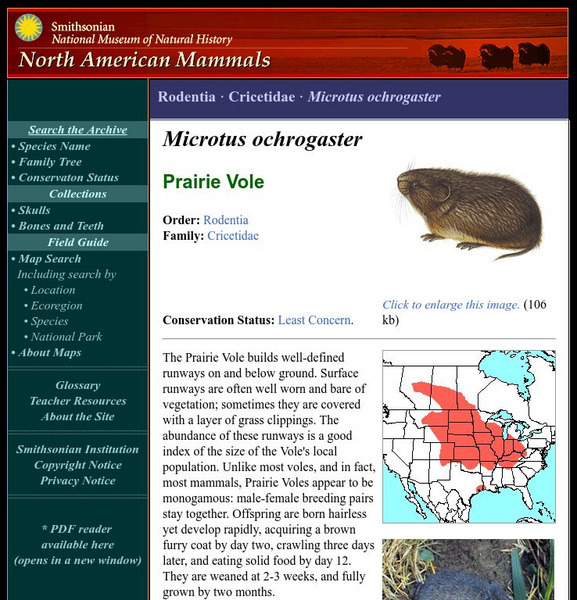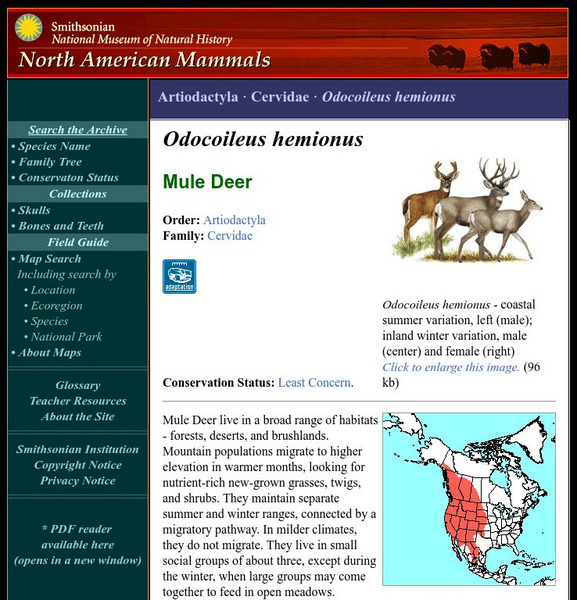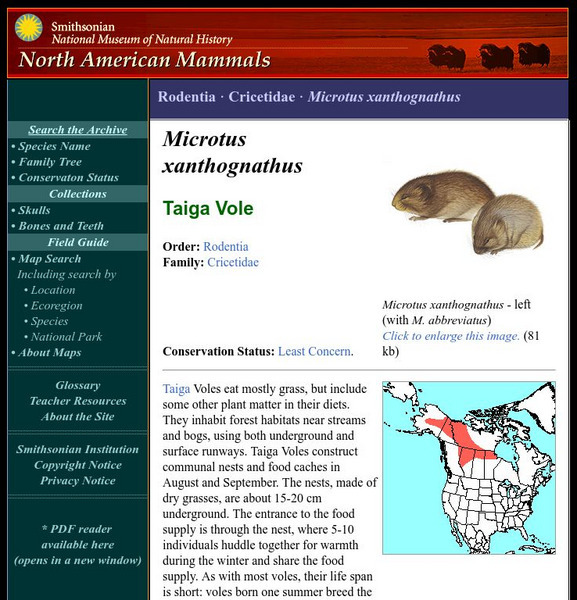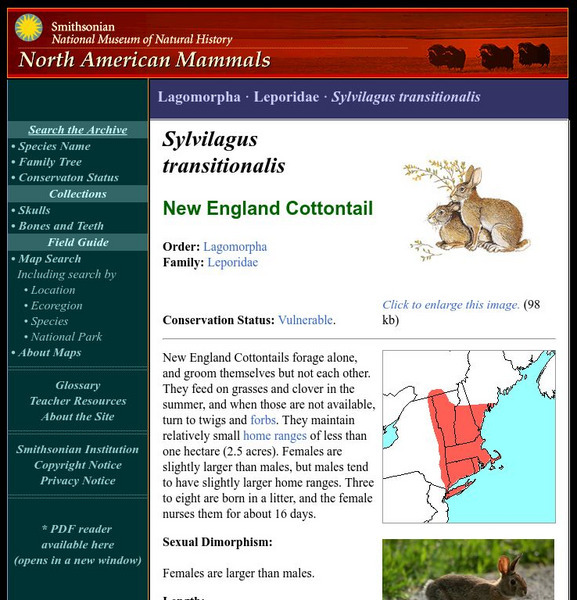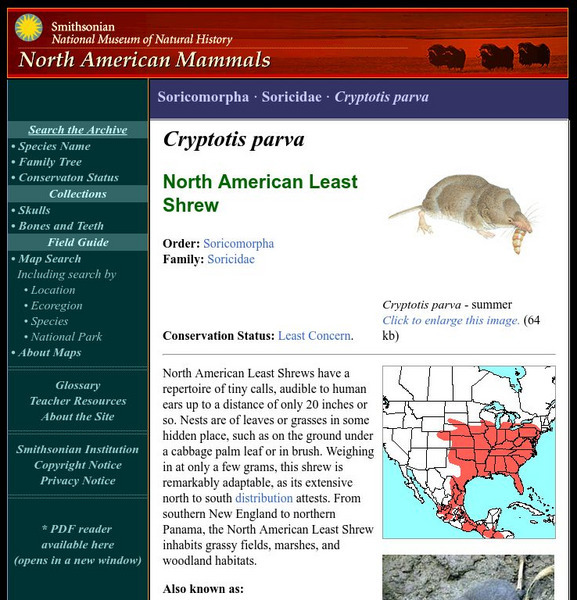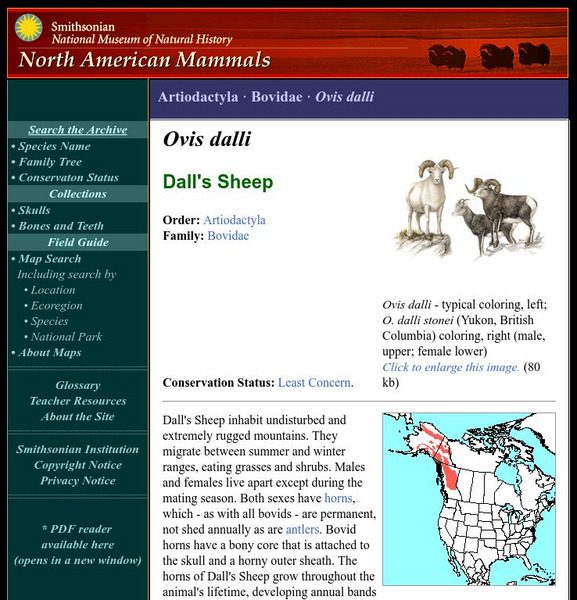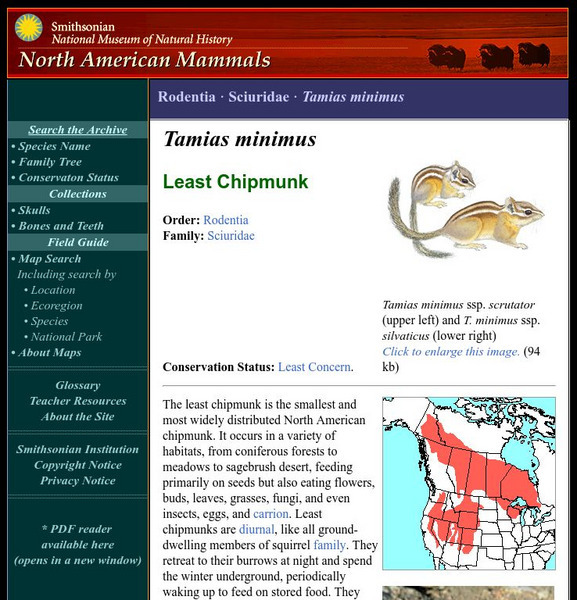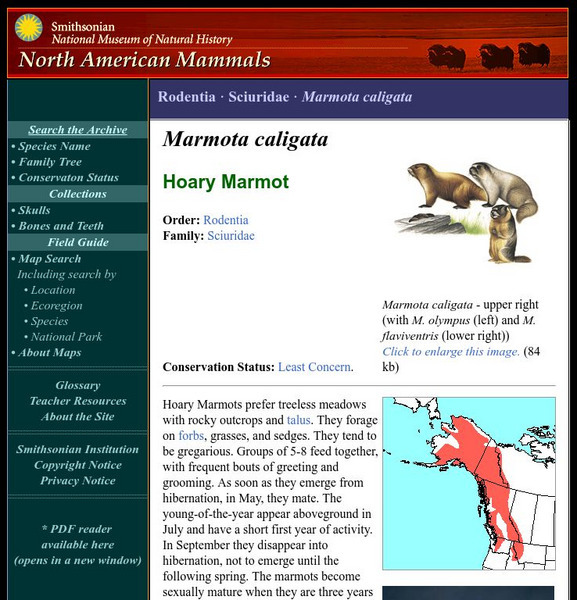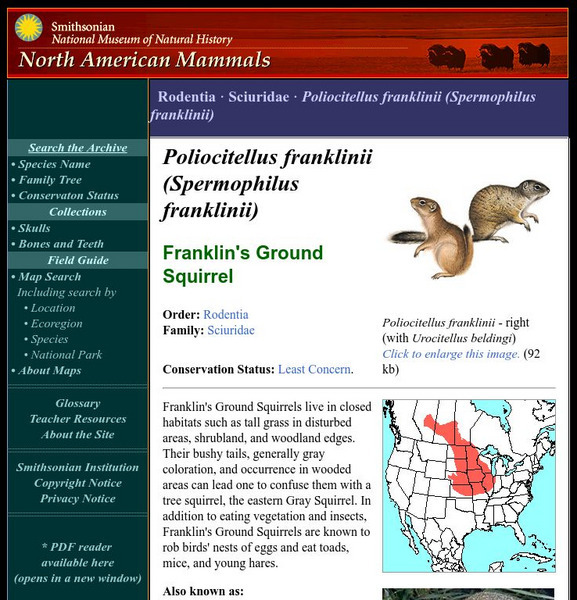Smithsonian Institution
National Museum of Natural History: American Mammals: Texas Mouse
Texas Mice need rocky environments. Where these occur, they are found in cedar glade, juniper-grass, and oak-juniper forests. Learn more about the Peromyscus attwateri, more commonly known as a Texas Mouse, in this easy-to-read species...
Smithsonian Institution
National Museum of Natural History: American Mammals: Mesquite Mouse
Mesquite Mice live in dense mesquite thickets known as bosques. Although mesquite is the dominant plant in bosques, other desert plants such as palo-verde, prickly pear, and cholla cacti, and grasses, mix with the mesquite. Learn more...
Smithsonian Institution
National Museum of Natural History: American Mammals: Yellow Nosed Cotton Rat
Voles and cotton rats usually live in different geographic regions, but both groups of small rodents eat grass and make runways. Yellow-nosed Cotton Rats are especially vole-like because they are small and live in grassy patches of...
Smithsonian Institution
National Museum of Natural History: American Mammals: Prairie Vole
The Prairie Vole builds well-defined runways on and below ground. Surface runways are often well worn and bare of vegetation; sometimes they are covered with a layer of grass clippings. Learn more about the Microtus ochrogaster, more...
Smithsonian Institution
National Museum of Natural History: American Mammals: Mule Deer
Mule Deer live in a broad range of habitats - forests, deserts, and brushlands. Mountain populations migrate to higher elevation in warmer months, looking for nutrient-rich new-grown grasses, twigs, and shrubs. Learn more about the...
Smithsonian Institution
National Museum of Natural History: American Mammals: Taiga Vole
Taiga Voles eat mostly grass, but include some other plant matter in their diets. They inhabit forest habitats near streams and bogs, using both underground and surface runways. Learn more about the Microtus xanthognathus, more commonly...
Smithsonian Institution
National Museum of Natural History: American Mammals: Merriam's Ground Squirrel
Merriam's Ground Squirrels live in high desert habitat dominated by big sagebrush, western juniper, and greasewood, and are also found in grasslands and agricultural lands. They eat grasses and forbs. Learn more about the Spermophilus...
Smithsonian Institution
National Museum of Natural History: American Mammals: Swamp Rabbit
The Swamp Rabbit is the largest North American cottontail, but has relatively short ears in proportion to its size. It forages for grasses, sedges, some tree seedlings, and other plants in marshy lowlands of the south-central United...
Smithsonian Institution
National Museum of Natural History: American Mammals: New England Cottontail
New England Cottontails forage alone, and groom themselves but not each other. They feed on grasses and clover in the summer, and when those are not available, turn to twigs and forbs. Learn more about the Sylvilagus transitionalis, more...
Smithsonian Institution
National Museum of Natural History: American Mammals: Mountain Cottontail
At dawn and dusk in the mountainous regions of the western United States, the Mountain Cottontail forages for sagebrush, western juniper, and grasses, almost always close to cover. As befits a rabbit that lives where it gets very cold,...
Smithsonian Institution
National Museum of Natural History: American Mammals: Northern Bog Lemming
Northern Bog Lemmings have a large geographic range, but they are seldom encountered, and the reason for their apparent scarcity is not known. Their preferred foods - sedges and grasses - are abundant, and they do not have very limiting...
Smithsonian Institution
National Museum of Natural History: American Mammals: Ord's Kangaroo Rat
By occupying the short grass prairie of the Great Plains, and a variety of habitats where there are fine-textured, sandy soils, Ord's Kangaroo Rat has managed a truly enormous geographic distribution. The varied habitats that it occupies...
Smithsonian Institution
National Museum of Natural History: American Mammals: North American Least Shrew
North American Least Shrews have a repertoire of tiny calls, audible to human ears up to a distance of only 20 inches or so. Nests are of leaves or grasses in some hidden place, such as on the ground under a cabbage palm leaf or in...
Smithsonian Institution
National Museum of Natural History: American Mammals: Dall's Sheep
Dall's Sheep inhabit undisturbed and extremely rugged mountains. They migrate between summer and winter ranges, eating grasses and shrubs. Learn more about the Ovis dalli, more commonly known as a Dall's Sheep, in this easy-to-read...
Smithsonian Institution
National Museum of Natural History: American Mammals: Insular Vole
There have been only scattered observations of the Insular Vole since 1885 because the two islands in the Bering Sea off the coast of Alaska where it lives are rather inaccessible. The Voles live in burrows dug in moist lowland areas, at...
Smithsonian Institution
National Museum of Natural History: American Mammals: Least Chipmunk
The least chipmunk is the smallest and most widely distributed North American chipmunk. It occurs in a variety of habitats, from coniferous forests to meadows to sagebrush desert, feeding primarily on seeds but also eating flowers, buds,...
Smithsonian Institution
National Museum of Natural History: American Mammals: Creeping Vole
Creeping Voles are found in moist coniferous forests at all stages of forest succession, from old growth to recent clear-cuts. In fact, population density is probably higher in recently cut areas where more sunlight reaches the ground...
Smithsonian Institution
National Museum of Natural History: American Mammals: Hoary Marmot
Hoary Marmots prefer treeless meadows with rocky outcrops and talus. They forage on forbs, grasses, and sedges. Learn more about the Marmota caligata, more commonly known as a Hoary Marmot, in this easy-to-read species overview by the...
Smithsonian Institution
National Museum of Natural History: American Mammals: Franklin's Ground Squirrel
Franklin's Ground Squirrels live in closed habitats such as tall grass in disturbed areas, shrubland, and woodland edges. Their bushy tails, generally gray coloration, and occurrence in wooded areas can lead one to confuse them with a...
Curated OER
Wikipedia: National Historic Landmarks in Missouri: Louis Bolduc House
This home was the residence of Louis Bolduc from around 1785 until his death in 1815. Bolduc was a lead miner, merchant, and planter, and was one of the local leaders of Ste. Genevieve, a small town. The house itself is an example of one...
Curated OER
Wikipedia: National Historic Landmarks in New Mexico: Santa Fe Plaza
Central park lined with grass, trees, and benches; Indian War Memorial monument; performing arts stage.
Curated OER
Educational Technology Clearinghouse: Maps Etc: North China, 1971
" North China includes the densely populated and intensively cultivated North China Plain, the loess-covered uplands of Shansi, northern Shensi, and eastern Kansu, and the sparsely populated, semiarid steppes of Inner Mongolia....



